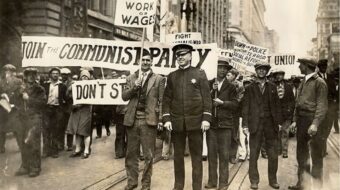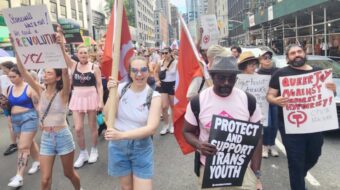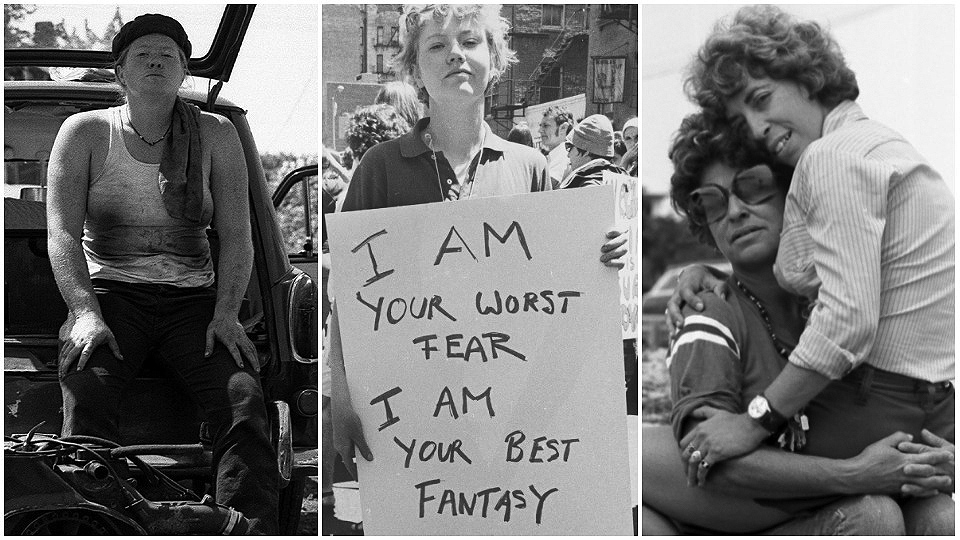
NEW YORK— On my now only occasional trips to New York City I often make time for a visit to the Leslie-Lohman Museum of Gay and Lesbian Art right in the heart of SoHo, the former hip artist district in Manhattan that has now been supplanted by Chelsea, a few subway stops north. The museum calls itself “the only LGBTQ art museum in the world,” aspiring “to reclaim scholarship from a queer perspective, provide a training ground for queer artists and cultural workers, examine the juxtaposition between art and social justice in ways that provoke dialogue and thought, while acting as a cultural hub for LGBTQ individuals and their communities.”
Three current shows here ask critical questions about gender, sexuality, and society. Is gender such a fixed quantity? The subject takes on new dimensions in light of the current administration’s campaign to erase transsexual identity. And can genderbending disrupt the system we live in by altering perceptions of property and propriety? All three shows invent new vocabulary to express the demands of the LGBTQ liberation movement.
First, though March 17, 2019, is Brave, Beautiful Outlaws: The Photographs of Donna Gottschalk, curated by Deborah Bright. It’s not a large show, but it’s very satisfying. Gottschalk did much of her work in the 1970s, an era of radical lesbian organizing, and she lived in both New York and California. She hung out with rebels, organizers, artists and writers such as JEB (Joan E. Biren), Flavia Rando, Sue Katz, Amber Hollibaugh and others, attending lesbian conferences and retreats, and for a time joining lesbian-separatist communities on the West Coast. Probably never anticipating the art-historical or archival nature of what she was doing at the time, she photographed herself, friends, lovers, and activists. She also documented the life of her sibling, a gay man named Alfie who transitioned to become a woman named Myla.
For forty-odd years these negatives, contact sheets and prints lay dormant. In part this can be explained by Gottschalk’s reticence to expose her subjects to public view, as many would not have appreciated being “outed” through her work. Also, many of her subjects posed nude, another reason they may not have wished their images to become widely seen. Some of the photographer’s images date from later as well, into the 1990s.
I did not see very much personal information on Gottschalk in the didactic material in the show, nor where she is now and what she may be working on, but one conclusion is clear: Whatever her family of origin had been, these photographs reveal a passionate attempt to recreate new “family” structures among a subsection of women who may have left their hometowns and relations far behind—or may have indeed been abandoned by them. The communities they established became, for many, more significant than their birth families.
One subject Gottschalk followed for some years and in diverse locales was Marlene, a tough dyke who confidently took on “men’s” work in garages and car repair shops. Another subject, captured only once by her lens, was a bar waiter in Provincetown, Mass., still a popular LBGTQ resort, in 1974. Gottschalk captioned her photo, “I saw this girl working in a bar. She was beautiful, proud, not afraid of anything. I had to photograph her.” The ephemera of yesteryear have become the artifacts of our collective history and iconography.
At the same time the photographer’s intimacy with her subjects grants the work a kind of timelessness. One can imagine her only last week saying to her lover, “Oh that’s so wonderful, the way you’re gesturing in the light just like that. Hold it, I want to preserve that image forever.”
The images are silent, but how they speak, and how they can scream too—at Pride demonstrations which she also documented. One photo in the show depicts Gottschalk herself at a Christopher Street Liberation Day parade holding a sign saying, “I AM YOUR WORST FEAR, I AM YOUR BEST FANTASY.”
Gottschalk formed part of a wave of women who called themselves the “Lavender Menace” or Radicalesbians, who fought to redefine gender relationships. In particular they challenged NOW and the mainstream Women’s Liberation movement to address lingering sexism and homophobia, and in that they achieved much of their purpose.
For many of her subjects, such as Marlene and Myla, this exhibition serves as the only “memorial” they will likely ever have.
A no longer forgotten genderqueer artist
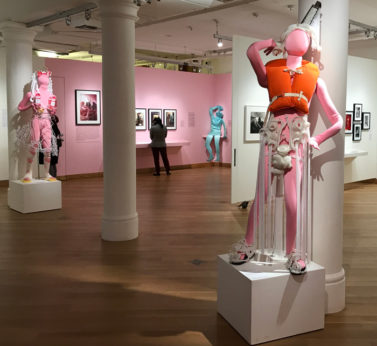
The second exhibition, and much larger, is Rubbish and Dreams: The Genderqueer Performance Art of Stephen Varble, curated by David Getsy, which runs through January 27, 2019. A native of Owensboro, Ky., born in 1946, in the 1970s Varble constructed elaborate costumes out of street trash, food waste, and stolen objects, and so dressed, as “Marie Debris,” invaded New York City art galleries, public spaces, and financial institutions to disrupt business as usual. His “gutter art” interventions, unannounced except to documentary photographers and videographers he invited to record his work, mocked institutionality on every level, including gender. His impromptu non-binary outrageousness challenged and mirrored the decay of New York City in that era, a time when “white flight” had left large parts of Manhattan virtual wastelands of drugs, homelessness, graffiti and poverty. After Varble died in 1984 of AIDS, his place in performance history was mostly forgotten, but this exhibition draws on a number of private archives in telling his story for the first time. The museum website offers video links to several of his performance pieces.
Claiming lesbian space
AND SO ARE YOU, the third exhibition, faces out from the museum windows around the corner onto both Wooster and Grand Streets. Large panels created by an anonymous art collective named “fierce pussy” that started working in 1991 reclaim words and insults as proud labels. Some of these terms may still feel transgressive to use in public, the way “queer,” “dyke” and even “faggot” once were but now are not if used with understanding, love and support.
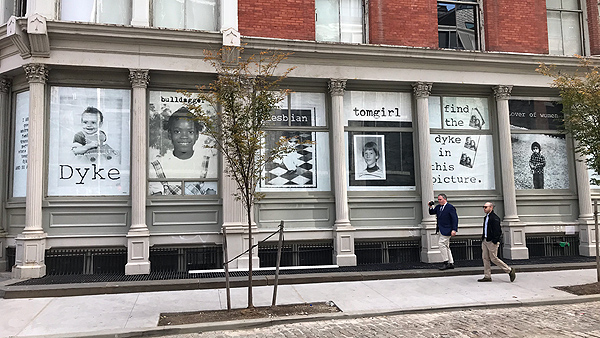
Big posters show images of some of the collective members as children whom society identified as “tomboys.” Many tomboys—at least the ones in fierce pussy—grew up to become women loving women. The derogatory epithets attached to them as children would have been most inappropriate at that age, such as “dyke” and “bulldagger,” but fierce pussy seems to be saying that the labels are premonitions and predictions of what these emergent women would become. At the same time, these images suggest some reconsideration of childhood sexuality, which the greater society considers a taboo subject.
In presenting themselves so forwardly, fierce pussy is claiming space and recognition for lesbian visibility in the larger LGBTQ culture that once ignored or sidelined them. They were heard: At one point, maybe a decade or so ago, it became “incorrect” to say GLBT, and the L started appearing first.
The work of these radical artists counters the overarching narrative which is dominated by the media, churches, schools and other institutions. It even challenges sectors of the mainstream LGBTQ movement which aim toward assimilation and tolerance in ways that often marginalize people of color, people living with disabilities, and the poor.
These bold posters confront passersby with the positive queerness of women, in writer Alexis Clements’s words, “declaring they are still here, that they still will not be easily defined, and that they cannot be ignored.”
A statement about the exhibition says, “AND SO ARE YOU is not only making queer space, and expanding the circle of that queer space, but serves as a provocation, to resist the dire political climate we find ourselves in.” This exhibition will be on view at least through June 2019.
All in all, an evocative, provocative afternoon at the museum!
The Leslie-Lohman Museum of Gay and Lesbian Art is located at 26 Wooster St., corner of Grand, New York, N.Y. 10013. Their phone number is (212) 431-2609, and their website can be reached here. Hours are Weds.-Sun. 12-6 pm, and Thurs., 12-8 pm.




